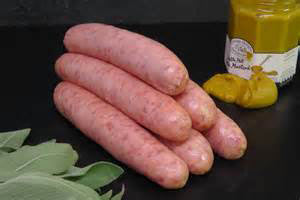A note on Cambridge sausages.
The Cambridge sausage represents that rare food, a product associated with the ancient university city. The sausages are unique in a number of ways but seldom seen anywhere anymore, whether in shops or in print. Jennie Reekie, for example, omits the item from British Charcuterie, while the great Jane Grigson omits any mention of it in her chapter on East Anglia from The Observer Guide to British Cookery, which appeared in the United States under the title British Regional Cookery.
The euphoniously named Antony and Araminta Hippisley Coxes claim in 1996 that the Cambridge variety “is probably the most popular sausage in England,” but they are uninformed outliers. The statement, like much else in their Great Book of Sausages, is both inexplicable and erroneous.
The Coxes could not have conducted an empirical survey because by the time they published their book Cambridge sausages had become decidedly thin on the ground, or rather at the butcher’s stall or supermarket. They probably had glanced instead at historical sources without insuring that their information remained accurate. In 1938, for instance, the “Handy Guide for Pork Butchers” described a “Far-Famed Cambridge Sausage,” and at least four other butchers’ handbooks from the thirties through the fifties include recipes. (localfoodheroes)
The fourth edition of Law’s Grocer’s Manual from 1949 describes Cambridge sausages but does not provide proportions; then again, Law’s, while a valuable resource for items available to the British shopper, and therefore reflects their tastes, does not provide recipes at all.
Glyn Lloyd-Hughes contends, citing Law’s, that Escoffier considered the seasoning of Cambridge sausages ‘excessive.’ (Lloyd-Hughes 119) While arguably true in strictest terms, the claim is somewhat misleading. 
In fact Escoffier spares scant space for fresh sausages, at least in the Editor’s American edition of his Guide to the Fine Art of Cookery. Out of nearly three thousand recipes, Escoffier identifies only three kinds of them, crepinettes, hot dogs (that of course he calls Frankfurt sausages) and Strasburg sausages, provides only three recipes for their use and two variations on the same way to make sausages themselves. While Escoffier does claim that “[t]heir seasoning is often excessive,” he is speaking of sausages generally and never identifies Cambridge or any other English sausage. (Escoffier 475)
Lloyd-Hughes’ citation to Law’s Grocer’s Manual, or at least its 1949 edition, provides no basis to support the claim that Escoffier considered the seasoning of Cambridge sausages excessive either. The entry on the sausage says no such thing but rather describes its components without editorial comment.
As to the question whether the seasoning of sausage in general is palatable, Escoffier ought to have chosen his language better unless, and it may be the case, he disliked sausages. While it is true that robust seasonings, always of salt, usually in England of sage and often of spice do characterize most species of sausage, all those additives procure a certain subtlety after the alchemy of grinding, seasoning, stuffing and then settling in situ for a couple of days. Aged sausages of course are altogether different. Their fermentation does lead to a kind of excess in the pursuit of pleasure, which as the zealot says is no sin.
To return to fresh varieties, Cambridge sausages represent a particular case in point. The inclusion of rice is unknown outside Louisiana even in Asia, and even in Louisiana the rice represents neither adjunct nor binder but rather the principal ingredient of boudin, the storied and spectacular Acadian concatenation of the rice, pork, its offal, some scallion and heat in the form of cayenne. Although rice gives the taste and texture of a Cambridge sausage a subtle difference from other varieties, it is difficult to discern its presence.
Rice of course is hardly ‘seasoning,’ but the seasoning of Cambridge sausages is both distinct and robust. Most recipes specify what does look like excessive amounts of allspice, cayenne, ginger, nutmeg, mace, especially white pepper and sometimes sage. The blend does not, however, produce anything unpleasant like a burning sensation. Instead these sausages taste lively.
Cambridge sausages are easy to make, and although unlike their Oxford counterparts always by tradition appear in casing, you could go the rival’s route and form them into gutless discs. You will need to cook some rice and should grind some shoulder of pork but even ground meat straight from the supermarket produces an excellent Cambridge sausage. The seasonings as we have seen are straightforward if unorthodox and ought to reside in the larder of any cook with the most casual interest in English food.
Help save an endangered culinary species and put up a batch of Cambridge sausage. Our own recipe, and a recipe for Cambridge sausage pudding adapted from Francatelli, appear in the practical.
Sources:
W. G. Copsey (ed.), Law’s Grocer’s Manual (London 1949)
Auguste Escoffier, The Escoffier Cookbook and Guide to the Fine Art of Cookery (New York 1989)
Jane Grigson, The Observer Guide to British Cookery (London 1984)
Antony & Araminta Hippisley Coxe, The Great Book of Sausages (Woodstock NY 1996; orig. publ. 1987)
www.localfoodheroes.co.uk/?e=765 (accessed 22 October 2015)
Jennie Reekie, British Charcuterie (London 1988)

